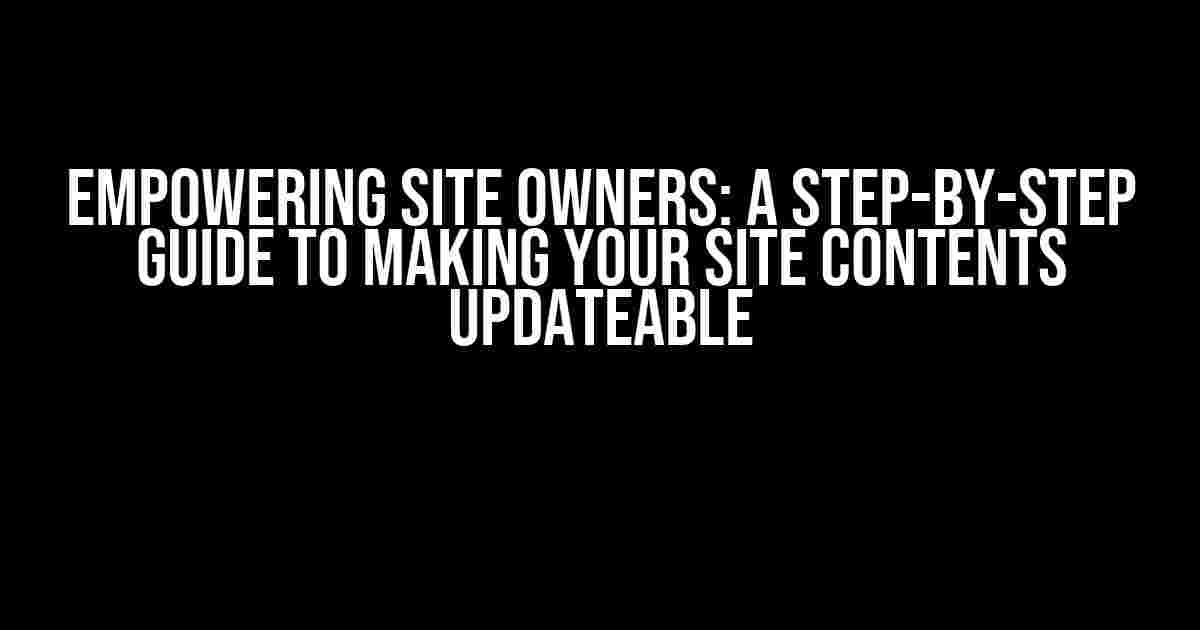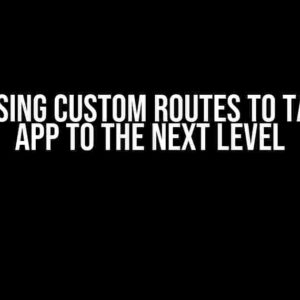Are you tired of being held hostage by web developers every time you want to make a simple change to your website’s content? Do you wish you could take control of your online presence and update your site’s contents whenever you want, without breaking the bank or needing to possess extensive coding skills? Well, you’re in luck! In this comprehensive guide, we’ll show you how to make your site contents updateable by the owner, so you can take charge of your website’s destiny.
Understanding the Problem: Why Inflexible Websites Are a Thing of the Past
In the past, websites were often built using static HTML, CSS, and JavaScript, which made it difficult for non-technical site owners to make changes to their content. This led to a situation where website updates were time-consuming, costly, and reliant on the availability of a web developer. However, with the advent of Content Management Systems (CMS) and modern web development frameworks, it’s now easier than ever to create dynamic websites that can be easily updated by site owners.
The Benefits of Updateable Site Contents
- Flexibility and Control**: With updateable site contents, you’re no longer reliant on a web developer to make changes to your website. You can update your content whenever you want, without needing to wait for someone else’s approval or availability.
- Cost-Effective**: By being able to update your site contents yourself, you can save money on development costs and focus on more important aspects of your business.
- Improved SEO**: Fresh and regularly updated content is essential for search engine optimization (SEO). With updateable site contents, you can ensure that your website stays relevant and attractive to search engines.
- Enhanced User Experience**: Updateable site contents allow you to respond quickly to changing user needs and preferences, ensuring a better user experience and increased engagement.
Step 1: Choose a Content Management System (CMS)
A Content Management System (CMS) is a platform that enables you to create, edit, and manage your website’s content without needing to write code. There are numerous CMS options available, each with its strengths and weaknesses. Some popular CMS options include:
| CMS Option | Pros | Cons |
|---|---|---|
| WordPress | Easy to use, massive community, extensive plugin library | Can be bloated, vulnerable to security issues |
| Joomla | Highly customizable, robust security features | Steeper learning curve, limited plugin availability |
| Drupal | Highly scalable, robust security features | Complex setup, steep learning curve |
| Wix | Easy to use, drag-and-drop interface, affordable | Limited flexibility, limited scalability |
For the purposes of this guide, we’ll assume you’ve chosen WordPress as your CMS of choice. However, the principles outlined here can be applied to other CMS platforms as well.
Step 2: Set Up Your CMS
Once you’ve chosen your CMS, it’s time to set it up. Here’s a brief overview of the process:
- Download and Install WordPress**: Visit the WordPress.org website and download the latest version of WordPress. Follow the installation instructions to set up WordPress on your website.
- Choose a Theme**: Select a theme that resonates with your website’s style and layout. You can choose from thousands of free and paid themes available in the WordPress theme directory or third-party marketplaces.
- Install Plugins**: Plugins are essential for extending WordPress’s functionality. Install plugins that enable features like contact forms, SEO optimization, and social media integration.
- Configure Basic Settings**: Update your site’s title, tagline, and timezone. Set up your navigation menu and configure your site’s permalink structure.
Step 3: Create Updateable Content
Now that your CMS is set up, it’s time to create updateable content. In WordPress, you can create two types of content:
- Pages**: Pages are static content that rarely changes, such as your About page or Contact page.
- Posts**: Posts are dynamic content that can be updated regularly, such as blog articles or news updates.
To create updateable content in WordPress, follow these steps:
// Create a new page or post// Enter your content using the visual editor or HTML editor
// Click the "Publish" button to make your content live

Step 4: Set Up User Roles and Permissions
To enable updateable site contents, you need to set up user roles and permissions in your CMS. In WordPress, you can create multiple user roles, each with its own set of permissions:
- Administrator**: Has full control over the website, including managing users, plugins, and themes.
- Editor**: Can manage and update website content, but cannot manage users or plugins.
- Author**: Can create and update their own content, but cannot manage other users’ content.
- Contributor**: Can create and edit their own content, but cannot publish it.
- Subscriber**: Can only view website content and cannot make any changes.
To set up user roles and permissions in WordPress, follow these steps:
// Go to the Users > Add New page// Enter the user's details and select their role
// Click the "Add New User" button to create the user account

Step 5: Train and Empower the Site Owner
The final step is to train and empower the site owner to update the website’s contents. This includes:
- Content Creation**: Teach the site owner how to create and edit content using the CMS’s visual editor or HTML editor.
- Content Management**: Show the site owner how to manage and organize their content using categories, tags, and menus.
- Media Management**: Teach the site owner how to upload and manage media files, such as images and videos.
- SEO Optimization**: Educate the site owner on basic SEO principles and how to optimize their content for search engines.
- Regular Updates**: Encourage the site owner to regularly update their content to keep their audience engaged and coming back for more.
By following these five steps, you can empower the site owner to take control of their website’s contents and make updates whenever they want, without needing to rely on a web developer.
Conclusion
Making your site contents updateable by the owner is a crucial step in creating a dynamic and engaging online presence. By choosing the right CMS, setting it up, creating updateable content, setting up user roles and permissions, and training the site owner, you can ensure that your website stays fresh, relevant, and attractive to your target audience. Remember, in today’s digital landscape, flexibility and control are key to online success.
Frequently Asked Question
Empowering site owners to update their website’s content with ease, without relying on developers? We’ve got you covered! Here are some frequently asked questions on how to make site contents updateable by the owner:
What is the best way to make my website’s content updateable by me?
One of the best ways is to use a Content Management System (CMS) like WordPress, Drupal, or Joomla. A CMS allows you to create, edit, and manage your website’s content without requiring extensive coding knowledge. You can update your website’s content using a user-friendly interface, making it easy to keep your website fresh and up-to-date.
How can I give permission to specific users to update certain sections of my website?
You can achieve this by implementing role-based access control (RBAC) in your CMS. RBAC allows you to assign different roles to users, each with varying levels of permission to access and update specific sections of your website. This way, you can grant specific users permission to update certain areas of your website while restricting access to sensitive areas.
What kind of training or support does the site owner need to update the website’s content?
Depending on the complexity of your website and the CMS used, the site owner may require some training or support to update the website’s content. This can include online tutorials, user manuals, or guided training sessions. Additionally, many CMS platforms offer built-in help resources and support forums to assist users in updating their website’s content.
Can I use a headless CMS to make my website’s content updateable by me?
Yes, a headless CMS is a great option! A headless CMS allows you to manage your website’s content through a user-friendly interface, and then use APIs to deliver that content to your website or application. This approach provides more flexibility and scalability, making it easier to update your website’s content without requiring extensive coding knowledge.
How often should I update my website’s content to keep it fresh and relevant?
It’s essential to update your website’s content regularly to keep it fresh and relevant. The frequency of updates depends on your business goals, target audience, and industry. A good rule of thumb is to aim to update your website’s content at least once a week, whether it’s a blog post, news article, or product update. This will help improve your website’s search engine ranking, engage your audience, and drive more traffic to your site.




